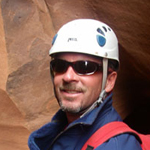New ACA Committee Members
The ACA has added our fourth Advisory Committee Member, Elisha Matthys. She has become not only an experienced canyoneer, but also an active member in the community teaming up in top rated canyons like Kolob and Imlay, becoming an ACA Leader 1, and participating in initiatives to promote the advancement of women canyoneers. She is smart, enthusiastic, and a pleasure to canyoneer with. Elisha and her husband Scott are assets to the ACA. We very much appreciate her offer to give us a hand. Looking forward to fun times ahead.
The ACA has a new Secretary! Scott Barlow has volunteered to help with organization and management of details associated with our programs. Scott and his wife Saori are known in the Utah canyoneering community for their love and enthusiasm for the sport. Calm, cool, and motivated, Scott will not only assist with our tasks, but will also give us a fresh perspective. We look forward to working with and learning from Scott.

 Scott Barlow
Scott Barlow




















